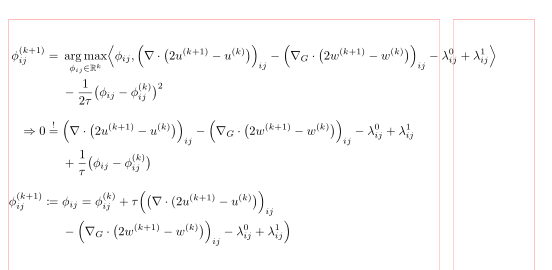Edit:
Since your page layout is unknown, it is difficult to suggest a solution for your problem. For simple move second lines to the left at use of article document class with default page layout your equation protrude oft of text area:
By using article document class, mathtools package, align math environment and standard syntax for adding arguments to math functions:
\documentclass{article}
\usepackage{mathtools, amssymb}
\DeclareMathOperator*{\argmax}{arg\,max}
%---------------- Show page layout. Don't use in a real document!
\usepackage{showframe}
\renewcommand\ShowFrameLinethickness{0.15pt}
\renewcommand*\ShowFrameColor{\color{red}}
%---------------------------------------------------------------%
\begin{document}
\begin{align*}
\phi_{ij}^{(k+1)}
= {} & \argmax_{\phi_{ij} \in \mathbb{R}^k}
\Bigl\langle \phi_{ij},
\Bigl(\nabla\cdot\bigl(2u^{(k+1)}-u^{(k)}\bigr)\Bigr)_{ij}
- \Bigl(\nabla_G\cdot\bigl(2w^{(k+1)}-w^{(k)}\bigr)\Bigr)_{ij}
- \lambda^0_{ij}+\lambda^1_{ij}
\Bigr\rangle \\
& - \frac{1}{2\tau}\bigl(\phi_{ij} - \phi_{ij}^{(k)}\bigr)^2 \\[2ex]
%
\Rightarrow 0 \overset{!}{=}{}
& \Bigl(\nabla\cdot\bigl(2u^{(k+1)}-u^{(k)}\bigr)\Bigr)_{ij}
- \Bigl(\nabla_G\cdot\bigl(2w^{(k+1)}-w^{(k)}\bigr)\Bigr)_{ij} - \lambda^0_{ij}+\lambda^1_{ij} \\
& + \frac{1}{\tau}\bigl(\phi_{ij} - \phi^{(k)}_{ij}\bigr) \\[2ex]
%
\phi^{(k+1)}_{ij}
\coloneqq {}& \phi_{ij} = \phi_{ij}^{(k)}
+ \tau \Bigl(\bigl(\nabla\cdot(2u^{(k+1)}-u^{(k)}\bigr)\Bigr)_{ij} \\
& - \Bigl(\nabla_G\cdot\bigl(2w^{(k+1)}-w^{(k)}\bigr)\Bigr)_{ij}
- \lambda^0_{ij}+\lambda^1_{ij}\Bigr)
\end{align*}
\end{document}

(red lines indicate part of page layout)
As you can see, first equation protrude right text area border. This can be solved by push one term more from the first line of the first equation to the second line:
\phi_{ij}^{(k+1)}
= {} & \argmax_{\phi_{ij} \in \mathbb{R}^k}
\Bigl\langle \phi_{ij},
\Bigl(\nabla\cdot\bigl(2u^{(k+1)}-u^{(k)}\bigr)\Bigr)_{ij} \\
& - \Bigl(\nabla_G\cdot\bigl(2w^{(k+1)}-w^{(k)}\bigr)\Bigr)_{ij}
- \lambda^0_{ij}+\lambda^1_{ij}
\Bigr\rangle
- \frac{1}{2\tau}\bigl(\phi_{ij} - \phi_{ij}^{(k)}\bigr)^2 \\[2ex]
which gives:

In the case, that you may define page layout with wider text area, for example by employ geometry package, a possible solution can be:
\documentclass{article}
\usepackage{geometry}
\usepackage{mathtools, amssymb}
\DeclareMathOperator*{\argmax}{arg\,max}
\begin{document}
\begin{align*}
\phi_{ij}^{(k+1)}
= {} & \argmax_{\phi_{ij} \in \mathbb{R}^k}
\Bigl\langle \phi_{ij},
\Bigl(\nabla\cdot\bigl(2u^{(k+1)}-u^{(k)}\bigr)\Bigr)_{ij}
- \Bigl(\nabla_G\cdot\bigl(2w^{(k+1)}-w^{(k)}\bigr)\Bigr)_{ij}
- \lambda^0_{ij}+\lambda^1_{ij}
\Bigr\rangle \\
& - \frac{1}{2\tau}\bigl(\phi_{ij} - \phi_{ij}^{(k)}\bigr)^2 \\[2ex]
%
\Rightarrow 0 \overset{!}{=}{}
& \Bigl(\nabla\cdot\bigl(2u^{(k+1)}-u^{(k)}\bigr)\Bigr)_{ij}
- \Bigl(\nabla_G\cdot\bigl(2w^{(k+1)}-w^{(k)}\bigr)\Bigr)_{ij}
- \lambda^0_{ij}+\lambda^1_{ij}
+ \frac{1}{\tau}\bigl(\phi_{ij} - \phi^{(k)}_{ij}\bigr) \\[2ex]
%
\phi^{(k+1)}_{ij}
\coloneqq {}& \phi_{ij} = \phi_{ij}^{(k)}
+ \tau \Bigl(\bigl(\nabla\cdot(2u^{(k+1)}-u^{(k)}\bigr)\Bigr)_{ij}
- \Bigl(\nabla_G\cdot\bigl(2w^{(k+1)}-w^{(k)}\bigr)\Bigr)_{ij}
- \lambda^0_{ij}+\lambda^1_{ij}\Bigr)
\end{align*}
\end{document}
which produce:








&, which is the designated indicator for the alignment point. You seem to be aware of this because you have mentioned&in the title. The&is best placed before a sign of relation, and if a continuation line does not include a sign of relation, place the&at the beginning followed by\quad. If you omit the&from any line, that line will be assumed to be wanted on the left-hand side, shoving all other lines to the right.